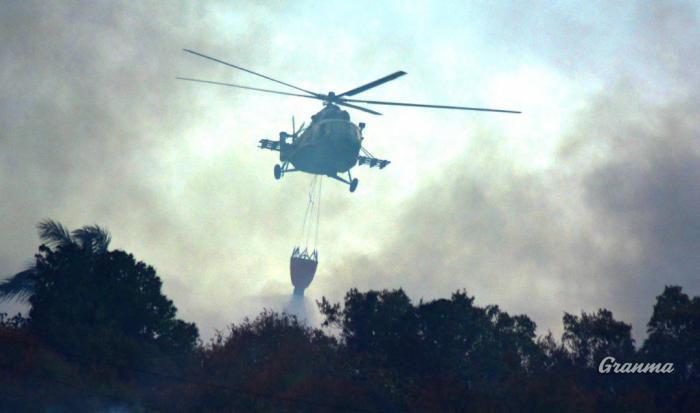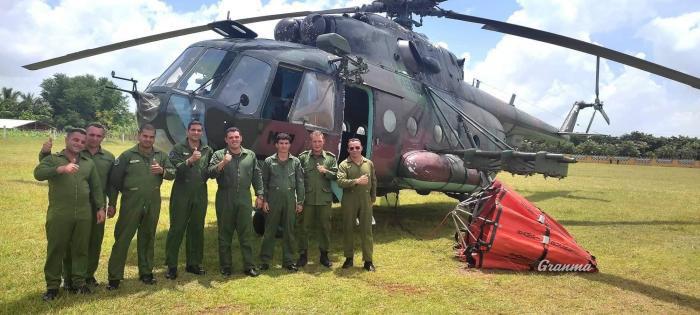
In the esplanade it is not clear whether the heat rises from the short and well-kept grass or descends from the inclement sun. The point is that there, in what the people of the air call their "basification zone," the temperature is as high as the sensation of immensity.
Of the five helicopters of the Revolutionary Armed Forces involved in fighting the fire at the Matanzas Supertanker Base -on the other side of the bay-, there are only two on the ground at that hour, the others are in full operation.
The crews, who will be flying again soon, take refuge in the shadows cast by their aircraft. Underneath them, underneath their powerful structures, anyone feels small, anyone but those who control them; and whose expertise is obvious at first sight.
Nothing is left to chance here. The rest and medical review protocols are inviolable. Major Geosvany Hernández Peña graduated in 2005 and is a ship's chief, what civilians know as a pilot.
He explains that the crew is composed of three people: chief of the ship, flight technician and co-pilot. In this mission, due to its complexity, two chiefs fly in the cockpit, but "the most experienced one is always in command."
The number of helicopters in the air depends on the situation; sometimes there is one, two or all of them are needed at the same time. The Chief of the Air Force remains at the scene of the accident with the firefighters, who are also pilots; they assess the scene together with the firefighters and decide how to proceed. It is not a matter of throwing and throwing water, there are specific points and times.
Hernández Peña summarizes the procedure: "We take off. From the air we maintain communication with the pointer. We fill up in the bay, and then we create a flight profile to make the “water attack.”
"We do it in a staggered manner; depending on how many aircraft are in the air, a safety distance is established between them. When the water is launched, the smoke rises, that's why we have to wait between one entry and another, only then the one behind can see. The flight time depends on the fuel.
The water is transported in the bambi bucket, a device that looks like a small bucket when viewed from the ground, but holds 2,500 liters of water and adds two and a half tons to the helicopter's suspended weight.
Lieutenant Reinier Martín and First Lieutenant Leonardo Díaz Guerra are aviation weapons specialists and operators of the bambi, which is controlled by a remote control and an electrical system that ensures it opens and closes.
They also give the helicopter the OK to fly. The pilots' lives are in their hands and vice versa. Flying is a matter of trust, that's why, they say, in the air they always exchange their visions. And to fl with the bambi on your back is not easy, you have to descend two meters above the sea to fill it, and then be very careful so that this kind of hanging bag does not collide with any structure.
Captain Sergio Luis García Fajardo, a 32-year-old pilot from Villa Clara, son of a pilot and father of a one-and-a-half-year-old boy, who used to be a member of his province's basketball team, talks about the dangers. "In flight, we avoid reaching places where there is a lot of combustion, because the engines need oxygen to work, and they can shut down, or any other failure can occur where it is very rarefied or there is none.
"There, too, visibility is reduced and orientation can be lost.” The other thing, they say, is the temperature, which makes the exhausting heat of this August midday seem like a breeze.
From the ground, says Major Geosvany, we are warned when we have to stop, but we sometimes alert them from the air.
For García Fajardo, who has been piloting for 13 years, this is undoubtedly one of the riskiest missions of his career. "For 30 days we were transporting oxygen for the COVID-19 patients, and it was dangerous, because any detail could have blown us up, but like this...".
"This has no comparison with anything I have ever seen," said first lieutenant Leonardo with obvious emotion, "there were flames almost next to the helicopter".
Major Dairon Gonzalez Espinosa, a 36-year-old from Granma who has been flying for 16 years, always circles the helicopter while touching it with one of his hands before taking off. However, he assures that up there, in front of a flame that is more than 200 meters higher than the height at which you are, and it surprises you to the front and to the left, the rituals are worthless, it is a matter of skill and calm.
"That's unimaginable. You have to live it. We knew that at any moment there could be an explosion because the smoke did not allow us to have direct visual contact with the tanks, with what was burning."
Their families keep calling them to take care of themselves, but they also tell them that they are proud; and they have a special motivation: "the brothers from the Ministry of the Interior who are missing.".
This day of fighting the fire, the panorama from the sky felt more controlled; visibility was much better and they were essentially working on preventing the fire from advancing towards other structures or into the undergrowth, and on cooling several points.
Again and again they repeat that their job is to support the firefighters, and it is true, but whoever saw live or through images the silhouette of those helicopters against the column of smoke, black and immense, has no doubt that these days, in Matanzas, courage is also in the air.
















